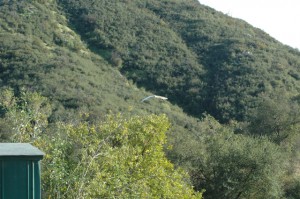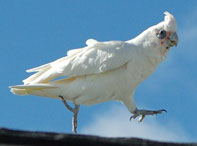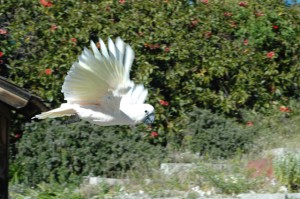 Moluccan cockatoo Sam had a big day in the open skies the other day. He looped several times around our 2 acres, floating on the soft, warm spring breezes. He looked stunning, to say the least….. So much that I almost forgot this moment was six years of training in the making.
Moluccan cockatoo Sam had a big day in the open skies the other day. He looped several times around our 2 acres, floating on the soft, warm spring breezes. He looked stunning, to say the least….. So much that I almost forgot this moment was six years of training in the making.
I love this guy to pieces, but he is not always an easy bird to love. I made a strong effort to teach this big guy to free-fly because I needed to find an outlet for all of his energy. I found the focused training sessions allowed him to develop a different relationship with me than the one he has rather abruptly developed with Andre.
At our house, he has a strong home base and even if he takes off on a spook flight he stays close. He is a very powerful, strong flyer, which means he runs out of juice quickly. When he realizes the tank is empty, he lands. Immediately. Sometimes this is on the ground. Sometimes, he ends up in a dreaded macadamia nut tree. Sam HATES macadamia trees, perhaps because the leaves have thorny, serrated edges. His screams echo throughout our valley, demanding that I come rescue him immediately. A wallflower, he is not.
 After his huge day of flying, poor Sammy was so tired he could not even hold his wings to his side. A tired moluccan cockatoo makes for a very peaceful household!
After his huge day of flying, poor Sammy was so tired he could not even hold his wings to his side. A tired moluccan cockatoo makes for a very peaceful household!
As much as Sam loves to be outside, conditioning him to enjoy the outdoor aviary has been taking a lot of time. There is a lot going on outdoors, and I regularly have red-shouldered, cooper’s, and red-tailed hawks, crows and ravens, hummingbirds, towhees, finches, scrub jays, and great blue herons, to name a few. Because of this activity, I always want to make sure Sam feels secure, even when I am not there. I started putting him in the aviary with his favorite foraging toys filled with nuts and seeds. These are extremely precious items to Sam, as he does not get whole nuts in the shell often; they are usually broken up and used for our daily training sessions. I also started by staying out there with him, hanging laundry, cleaning the patio, or working on projects. I gradually started going inside for short periods of time, only while he was busy.
From there, I began leaving him alone in the aviary for longer and longer periods of time, starting with one or two minutes, and then gradually increasing the time and ambient activity, making sure to keep the intervals confined to the amount of time I know Sam will be quiet. Because his voice is so…. tremendous… I can imagine if he started sounding off a little too much I might annoy my (few) neighbors in this rural area.
Even if I didn’t have to worry about disturbing neighbors, allowing Sam to scream his head off to no avail until he gives up is not exactly the type of behavior management I 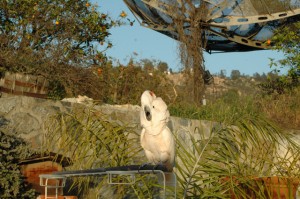 believe in (see “Learned Helplessness”). Incessant screaming is a learned behavior, it’s not something a parrot automatically does for no reason. It is a signal of some form of discomfort or stress: the parrot learns to make loud noise because it has in the past brought about some change his immediate environment, however small, fleeting, or unpleasant that change might seem to us. If I teach Sam that his behavior to signal he is stressed is useless, then he might give up. I might see a decrease in behavior overall. Or he might escalate his signals of stress in order to bring about the desired change. Dr. Susan Friedman teaches us that behavior is a tool to help us change our environmental conditions. Part of our overall physiological health is that we are able use our behavior to achieve the outcomes we desire.
believe in (see “Learned Helplessness”). Incessant screaming is a learned behavior, it’s not something a parrot automatically does for no reason. It is a signal of some form of discomfort or stress: the parrot learns to make loud noise because it has in the past brought about some change his immediate environment, however small, fleeting, or unpleasant that change might seem to us. If I teach Sam that his behavior to signal he is stressed is useless, then he might give up. I might see a decrease in behavior overall. Or he might escalate his signals of stress in order to bring about the desired change. Dr. Susan Friedman teaches us that behavior is a tool to help us change our environmental conditions. Part of our overall physiological health is that we are able use our behavior to achieve the outcomes we desire.
So… what’s the solution? Run to Sam as soon as he screams??? Not at all. We ignore the 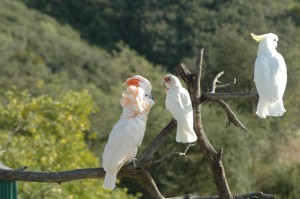 behavior we don’t want while reinforcing for the behavior we do want! We replace the behavior of screaming with another behavior we find more pleasant that offers Sam the same – or better – consequence. Remember what we tell a small child that is so upset he is blubbering in unintelligible mumbles and monosyllabic noises? “Use your words!” YES! Our vocabulary is absolutely shaped by differential social responses, even across species! We teach the screaming parrot that other noises are far more effective in getting our attention and bringing about that change.
behavior we don’t want while reinforcing for the behavior we do want! We replace the behavior of screaming with another behavior we find more pleasant that offers Sam the same – or better – consequence. Remember what we tell a small child that is so upset he is blubbering in unintelligible mumbles and monosyllabic noises? “Use your words!” YES! Our vocabulary is absolutely shaped by differential social responses, even across species! We teach the screaming parrot that other noises are far more effective in getting our attention and bringing about that change.
Two things to think about when looking at problem behavior: Prevent and replace. With Sam, preventing screaming in the outdoor aviary is relatively simple because I can give him so much to do there that he doesn’t get to do normally. He gets so busy his doesn’t always notice me coming and going. And once I leave – usually the act of leaving is the stimulus that brings about the most noise… or “contact calling” (more like contacting my neighbors from 5 miles away) – his behavioral momentum is moving toward a more constructive path than acknowledging my absence in an unfamiliar place.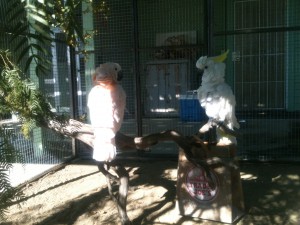
The end result is a parrot that is perfectly happy playing in his aviary, even as he sees me doing yardwork in the distance, walking in and out of his line of view, stopping every once in a while to say hello and offer a new foraging opportunity. Whew! It has been a long, very systematic road, but well worth the cost for the wonderful benefit of extended outdoor playtime!
Yours in systematic desensitization,
hh

